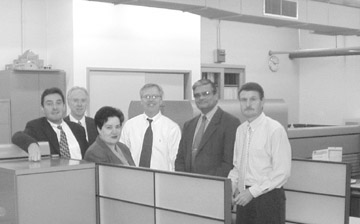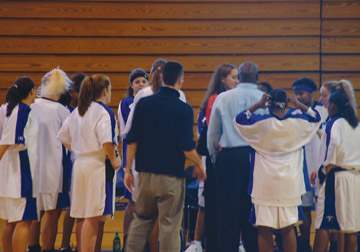Working from the Inside Out

The Facilities Design and Construction Department. – Photo by Carl Brooks
November 12, 2003
As UMass Boston stands poised to open the nifty new Campus Center and struggles to hold the line against deteriorating infrastructure elsewhere on campus, a small group far below the everyday surface of the campus works diligently to fix those nagging and depressing problems we all can’t help but notice.
The Facilities Design and Construction Department, headed up by Frank Traknyak is a little-known department at UMB that is, according to Traknyak, “basically an architectural firm,” located in the service building. With the exception of massive projects like the Campus Center and the ailing parking garage, the D and C team plan and execute all the construction, renovation and upgrades to the UMB campus. They draw up all the plans, hire out the jobs to contractors or co-ordinate with the maintenance offices and certify all the new work with the state.
Traknyak is realistic about the problems his office faces with the crumbling 30-year-old UMB campus. “I’m here for the challenge,” he said, explaining that many things in the UMB campus weren’t done right to begin with. Some of the problems in the garages have been blamed on sub-standard concrete, and many of the air and plumbing systems were cheap and now are outdated.
Traknyak is a fully licensed plumbing engineer. All of his staff are licensed architects or engineers, which allows them to sign off on completed projects for state approval. Traknyak actually helped to write the guidelines the state uses to certify public projects before coming to UMass, and one of his office’s projects is commissioning the new building for use.
Many of the biggest D and C projects are hidden from the daily view of students, like the new HVAC systems that cool and heat the campus. One of their biggest projects to date was the installation of enormous air conditioning units, or “chillers,” to complement new boilers installed last year. The revamped climate control system is state of the art and cost $1.6 million. Traknyak estimates that the new chillers, which recycle seawater from the harbor, will save UMB close to $400,000 in energy costs. The campus in also in the process of transitioning to natural gas for it’s boilers. Traknyak says that one of his main goals is to bring energy systems up to date to increase the efficiency of the campus and make it more environmentally friendly.” There are so many things in need of repair. I felt we needed to start with the basics.”
Another big project is a campus-wide water filtration system to reduce lead levels and remove contaminents from drinking water. Prioritized after reports last year indicated campus water was unfit to drink, the filtration system is undergoing final tests this week.
Aside from these invisible quality-of-life changes, many students might still be asking themselves why the campus looks so shoddy in places. According to Paul North, architect in the D and C offices, budget cuts have hit them hard. “Things get re-prioritized all the time,” he admits. “Budget cuts are pulling at the department hard. Until the fiscal crisis is over, the department won’t work comfortably.”
Other improvements on the wish list? New dugouts for the softball field, which North says will “make it the best facility in the state.” Meanwhile, projects like the renovation of Wheatley’s first floor have been extended as the department redistributes their workload in the face of staff reductions. Department staff has been reduced from 12 to six, and Traknyak says the office is busier than it’s ever been. “We’ve got fifty projects going right now,” he says.
Traknyak is trying to get the department more recognition for its potential to save the university money, saying, “I want to bring accountability to what we do.”
“We’re trying to bring the quality of the private sector to the state, like better quality design documents and change orders. In the real world, we would be very profitable.”






















































